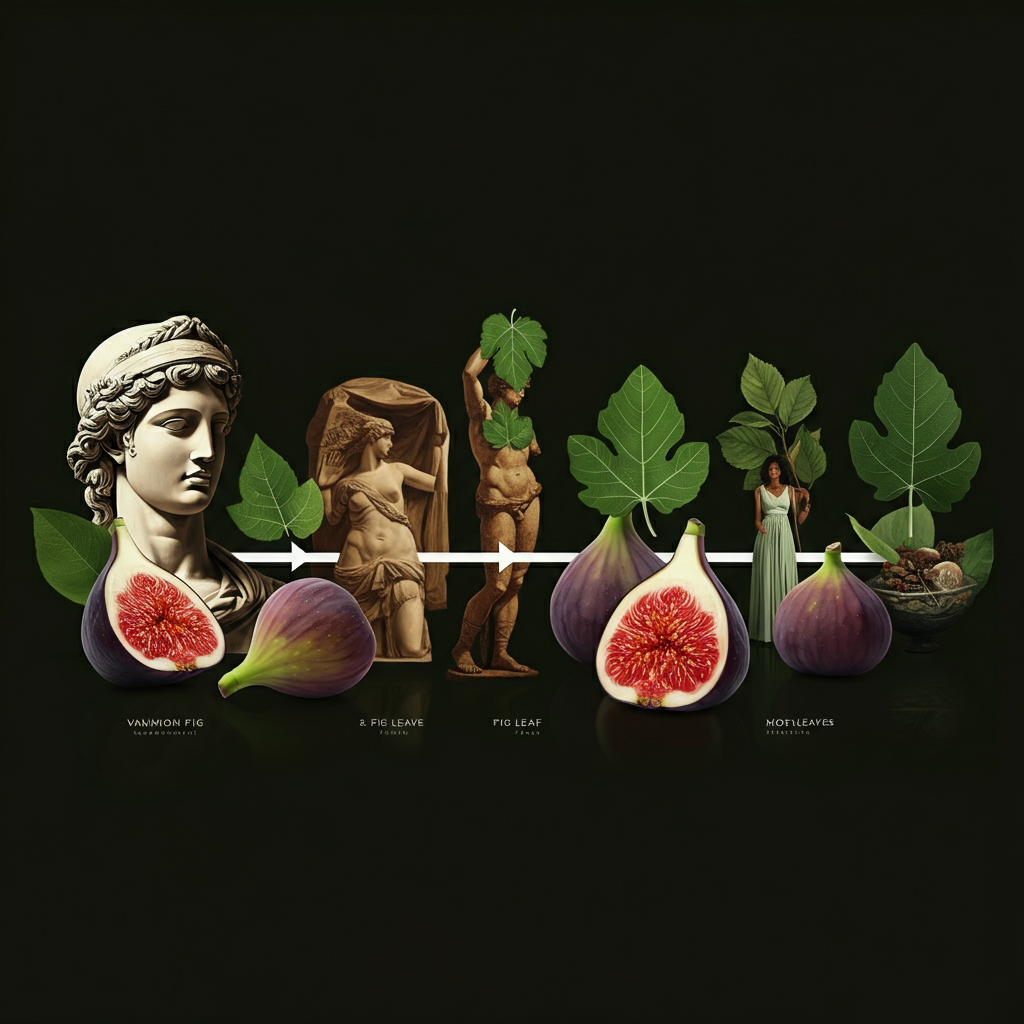When you think about where fig leaves first came into fashion, you might picture ancient Greek statues or biblical stories. But the real history of fig leaves as a fashion statement goes much deeper than most people realize. These simple leaves have played a surprising role in human culture for thousands of years.
Fig leaves became fashionable not just as clothing, but as symbols of modesty, protection, and even rebellion. From ancient civilizations to modern runways, these natural coverings have told stories about how humans view their bodies and express themselves through what they wear.
The Ancient Origins of Fig Leaf Fashion
Where It All Started: Ancient Mesopotamia
The story of where fig leaves first came into fashion begins in ancient Mesopotamia around 3000 BCE. Archaeological evidence shows that people in this region used fig leaves for practical purposes long before they became symbolic. The leaves were large, flexible, and naturally water-resistant, making them perfect for early clothing needs.
Ancient Sumerian texts mention fig leaves in their creation myths, suggesting these leaves held special meaning from humanity’s earliest stories. The Epic of Gilgamesh, one of the world’s oldest written stories, references fig leaves as coverings that connected humans to nature. This wasn’t just about hiding the body – it was about showing respect for natural materials and the earth itself.
Clay tablets from this period show figures wearing leaf-based clothing during religious ceremonies. These weren’t everyday outfits, but special garments for important occasions. The leaves were often decorated with natural dyes and combined with other plant materials to create elaborate designs that impressed both gods and fellow humans.
Egyptian Influence on Fig Leaf Fashion
Ancient Egypt played a crucial role in developing where fig leaves first came into fashion as we understand it today. Egyptian priests and priestesses wore fig leaf garments during specific rituals dedicated to fertility gods. These weren’t simple coverings but carefully crafted pieces that took hours to prepare.
Egyptian artwork from tomb paintings shows that fig leaves were often layered and sewn together with plant fibers. The wealthy classes would have servants prepare these garments with intricate patterns that showed social status. Some fig leaf clothing pieces were even preserved through mummification, showing how valuable they were to ancient Egyptians.
The Egyptians also developed techniques for preserving fig leaves that lasted months. They would treat the leaves with natural oils and plant extracts, creating flexible materials that could be stored and reused. This innovation helped spread fig leaf fashion to other civilizations through trade routes along the Nile River.
Biblical Connections and Cultural Impact
The Garden of Eden Story
When discussing where fig leaves first came into fashion, we can’t ignore the biblical account in Genesis. According to this story, Adam and Eve used fig leaves to cover themselves after gaining knowledge of good and evil. This narrative became one of the most influential fashion stories in human history.
The biblical fig leaf wasn’t just about modesty – it represented humanity’s first attempt at self-expression through clothing. Religious scholars have noted that the choice of fig leaves, rather than other available plants, suggests these leaves had special significance even in paradise. The leaves were described as being sewn together, indicating that even the first humans understood basic garment construction.
This story spread throughout Jewish, Christian, and Islamic cultures, making fig leaves a universal symbol of modesty and human awareness. The influence of this narrative helped establish fig leaves as acceptable and even sacred coverings in many religious traditions. Even today, religious artwork often depicts biblical figures wearing fig leaf garments.
Religious Art and Sculpture
Renaissance artists played a major role in keeping fig leaf fashion visible in popular culture. When creating religious artwork, painters and sculptors often used fig leaves to cover nude figures in biblical scenes. This practice helped maintain religious appropriateness while preserving artistic beauty.
Famous artists like Michelangelo and Leonardo da Vinci included detailed fig leaf coverings in their religious works. These weren’t afterthoughts but carefully designed elements that added to the overall artistic message. The truefashionstory.com blog has explored how these artistic choices influenced later fashion trends.
Church authorities during this period actually encouraged artists to include fig leaf coverings in their work. This created a demand for artists who could paint realistic and beautiful leaf garments. The skill required to depict convincing fig leaf clothing became a mark of artistic talent and religious sensitivity.
Greek and Roman Fashion Influences
Classical Mythology and Leaf Garments
Greek and Roman cultures significantly contributed to where fig leaves first came into fashion in the ancient world. Greek mythology includes numerous stories of gods and nymphs wearing natural leaf garments, with fig leaves being particularly popular among forest deities and nature spirits.
The Greeks associated fig leaves with Dionysus, the god of wine and celebration. During Dionysian festivals, participants would wear fig leaf crowns and garments as part of their ceremonial dress. These weren’t just religious requirements but became fashionable statements that showed cultural sophistication and spiritual awareness.
Roman adoption of Greek traditions brought fig leaf fashion to a wider audience. Roman nobles would wear fig leaf accessories during certain religious festivals, and these items became status symbols. The leaves were often gilded or decorated with precious stones, transforming simple natural materials into luxury fashion items.
Theater and Performance
Ancient Greek and Roman theater helped popularize fig leaf fashion among common people. Actors playing forest spirits, nature gods, and mythological creatures wore elaborate fig leaf costumes that impressed audiences. These theatrical designs influenced everyday fashion choices and made leaf-based clothing more acceptable in daily life.
Theater costume makers developed techniques for creating durable fig leaf garments that could withstand multiple performances. They would layer treated leaves with fabric backing and add decorative elements that caught stage lighting. These innovations spread to regular clothing makers and influenced civilian fashion trends.
The popularity of theatrical fig leaf costumes led to the development of artificial versions made from fabric and leather. These reproductions allowed ordinary people to adopt the look without access to fresh leaves or preservation techniques. This marked an important transition from purely natural materials to manufactured fashion items.
Medieval Period Developments
Monastic Traditions
During the medieval period, where fig leaves first came into fashion took on new religious significance within Christian monasteries. Monks and nuns used fig leaves symbolically in their illuminated manuscripts and religious art, keeping the tradition alive during the Dark Ages.
Medieval religious communities maintained gardens specifically for growing fig trees to supply leaves for religious ceremonies. These communities developed preservation techniques that allowed fig leaves to be stored through winter months. The knowledge of these techniques was carefully guarded and passed down through religious orders.
Some medieval religious orders incorporated fig leaf symbolism into their habits and ceremonial garments. While they didn’t wear actual leaves, they used leaf patterns and designs that referenced biblical traditions. This kept fig leaf fashion connected to spiritual practices during a period when secular fashion was limited.
Artistic Renaissance
The medieval period saw fig leaf fashion preserved primarily through artistic expression. Manuscript illuminators and church artists continued depicting biblical figures in fig leaf garments. These artistic traditions helped maintain cultural memory of fig leaf fashion until it could experience renewed popularity during the Renaissance.
Medieval artists developed stylized ways of depicting fig leaves that emphasized their symbolic rather than practical aspects. These artistic conventions influenced how later generations understood and interpreted fig leaf fashion. The truefashionstory.com blog has documented how medieval art influenced modern interpretations of historical fashion.
Tapestry makers during this period created elaborate wall hangings featuring biblical scenes with detailed fig leaf garments. These textiles helped spread awareness of fig leaf fashion among wealthy households and influenced secular clothing trends. The technical skill required for these works elevated fig leaf designs to high art status.
Renaissance Revival and Artistic Expression
Michelangelo and the Sistine Chapel
The Renaissance marked a significant revival in where fig leaves first came into fashion, particularly through Michelangelo’s work in the Sistine Chapel. His famous frescoes depicted Adam and Eve with carefully rendered fig leaf coverings that became iconic images recognized worldwide.
Michelangelo’s artistic interpretation of fig leaves influenced fashion designers and artists throughout Europe. His attention to detail in showing how leaves naturally fell and folded helped establish visual standards for fig leaf depictions. These artistic choices affected how people imagined and created actual fig leaf garments.
The controversy surrounding nudity in religious art led to the addition of fig leaves to many classical sculptures and paintings. This practice, sometimes called “fig-leafing,” created a renewed interest in how these natural coverings could be both modest and artistic. The technique influenced secular fashion by showing how natural materials could be both practical and beautiful.
Botanical Accuracy in Art
Renaissance artists’ focus on botanical accuracy brought new attention to the actual properties of fig leaves in fashion applications. Artists studied real fig leaves to understand their structure, texture, and draping qualities. This scientific approach influenced how fig leaf garments were designed and constructed.
The period’s emphasis on classical learning led to renewed interest in ancient texts describing fig leaf fashion. Scholars translated Greek and Roman writings about leaf-based clothing, providing historical context that influenced contemporary fashion designers. This academic approach elevated fig leaf fashion from simple covering to sophisticated clothing option.
Art academies began teaching proper techniques for depicting fig leaf garments, creating a generation of artists skilled in showing natural materials as clothing. This educational focus helped establish visual standards that influenced fashion illustration and design for centuries to come.
Cultural Variations Across Civilizations
Asian Interpretations
While where fig leaves first came into fashion is often associated with Western traditions, Asian cultures developed their own relationships with fig leaves in clothing and decoration. In ancient India, fig leaves were used in religious ceremonies and considered sacred materials connected to spiritual enlightenment.
Buddhist and Hindu traditions incorporated fig leaves into ceremonial garments worn during specific festivals and religious observances. These weren’t everyday clothing items but special garments that connected wearers to natural cycles and spiritual practices. The leaves were often combined with other natural materials to create elaborate ceremonial costumes.
Chinese and Japanese cultures used fig leaves decoratively rather than as primary clothing materials. Fig leaf patterns appeared in textile designs, pottery, and architectural elements. While not worn directly, these decorative uses kept fig leaf imagery present in daily life and influenced fashion sensibilities.
African and Indigenous Connections
African cultures developed unique approaches to where fig leaves first came into fashion that emphasized community connections and seasonal celebrations. Various tribes used fig leaves in coming-of-age ceremonies and seasonal festivals, creating garments that marked important life transitions.
Indigenous communities worldwide have used local fig varieties in traditional clothing for thousands of years. These practices developed independently from Mediterranean and Middle Eastern traditions, showing that fig leaf fashion emerged naturally in multiple human cultures. Each community developed unique techniques for preparing and wearing leaf-based garments.
The diversity of fig leaf traditions across cultures demonstrates that humans naturally gravitate toward using these materials for clothing and decoration. This universal appeal suggests that fig leaves possess qualities that make them inherently suitable for fashion applications across different climates and cultural contexts.
Modern Interpretations and Fashion Trends
Contemporary Designer Applications
Modern fashion designers have rediscovered where fig leaves first came into fashion and incorporated these historical elements into contemporary clothing lines. High-end designers create garments inspired by classical fig leaf imagery while using modern materials and construction techniques.
Sustainable fashion movements have embraced fig leaf concepts as examples of environmentally friendly clothing options. Designers experiment with actual preserved fig leaves and fig leaf-inspired patterns to create eco-conscious fashion statements. These modern interpretations connect historical traditions with contemporary environmental awareness.
Fashion weeks around the world have featured collections that reference classical fig leaf imagery. These shows often combine historical research with modern innovation, creating garments that honor traditional uses while meeting contemporary fashion needs. The results demonstrate how ancient fashion concepts can inspire modern creativity.
Digital Age and Social Media
Social media platforms have created new opportunities for exploring where fig leaves first came into fashion through educational content and artistic expression. Fashion historians use these platforms to share research about historical leaf-based clothing and its cultural significance.
Online communities dedicated to historical fashion have rekindled interest in fig leaf traditions. Members share reproduction techniques, historical research, and modern interpretations of classical fig leaf garments. These communities help preserve traditional knowledge while encouraging creative adaptations for modern use.
Digital art and virtual fashion have embraced fig leaf imagery as a way to explore themes of nature, modesty, and historical connection. Virtual clothing designers create digital garments that reference classical fig leaf traditions while exploring futuristic fashion concepts.
Table Comparison: Fig Leaves vs. Other Natural Materials
|
Material |
Durability |
Flexibility |
Cultural Significance |
Availability |
Modern Use |
|---|---|---|---|---|---|
|
Fig Leaves |
Medium |
High |
Very High |
Seasonal |
Symbolic/Artistic |
|
Palm Fronds |
High |
Medium |
Medium |
Regional |
Construction/Decor |
|
Grape Leaves |
Low |
High |
Medium |
Seasonal |
Culinary/Ceremonial |
|
Oak Leaves |
Medium |
Low |
High |
Seasonal |
Ceremonial |
|
Banana Leaves |
Medium |
High |
Low |
Tropical |
Culinary/Packaging |
The Psychology Behind Fig Leaf Fashion
Modesty and Self-Expression
The psychological appeal of where fig leaves first came into fashion connects to fundamental human needs for both modesty and self-expression. Fig leaves represent a compromise between natural nudity and artificial clothing, satisfying psychological needs while maintaining connection to nature.
Research in fashion psychology suggests that natural materials like fig leaves trigger positive emotional responses related to environmental connection and authenticity. People wearing or viewing fig leaf-inspired fashion often report feelings of groundedness and spiritual connection that artificial materials don’t provide.
The historical associations of fig leaves with biblical and classical traditions add layers of psychological meaning that influence modern interpretations. These connections create emotional responses that go beyond simple aesthetic appreciation to include cultural and spiritual significance.
Symbolism in Modern Context
Contemporary interpretation of fig leaf fashion often focuses on themes of environmental awareness and sustainable living. Modern wearers of fig leaf-inspired clothing use these garments to express values about natural living and environmental responsibility.
The symbolic power of fig leaves in modern fashion extends to concepts of authenticity and rejection of artificial consumer culture. People choosing fig leaf-inspired fashion often seek to make statements about returning to natural materials and traditional ways of living.
Social movements focused on body positivity and natural acceptance have embraced fig leaf imagery as symbols of natural beauty and self-acceptance. These contemporary uses demonstrate how ancient fashion concepts continue to evolve and find relevance in modern cultural contexts.
Key Takeaways
Understanding where fig leaves first came into fashion reveals important insights about human culture and fashion history:
- Ancient origins: Fig leaf fashion began in Mesopotamia around 3000 BCE as practical clothing
- Religious significance: Biblical traditions made fig leaves universal symbols of modesty
- Artistic influence: Renaissance artists revived and popularized fig leaf imagery
- Cultural universality: Multiple civilizations independently developed fig leaf fashion traditions
- Modern relevance: Contemporary designers continue drawing inspiration from historical fig leaf fashion
- Environmental connection: Fig leaves represent sustainable and natural fashion choices
- Psychological appeal: Natural materials trigger positive emotional responses in wearers and viewers
Frequently Asked Questions
Q: Why were fig leaves specifically chosen for clothing in ancient times?
A: Fig leaves were selected because they’re large, flexible, naturally water-resistant, and readily available in Mediterranean climates. Their size made them practical for covering, while their durability allowed for multiple uses.
Q: Did people actually wear fig leaves as regular clothing?
A: While fig leaves were used for clothing in some cultures, they were more commonly worn for ceremonial, religious, or symbolic purposes rather than daily wear. Most evidence suggests they were special-occasion garments.
Q: How did artists preserve fig leaves for artistic purposes?
A: Ancient and Renaissance artists developed techniques using natural oils, plant extracts, and careful drying processes to preserve fig leaves. Some cultures used wax treatments and proper storage methods to extend leaf life.
Q: Are there modern fashion designers who use actual fig leaves?
A: Some contemporary eco-fashion designers experiment with preserved fig leaves, but most modern “fig leaf fashion” uses fig leaf patterns, shapes, or inspiration rather than actual leaves due to durability concerns.
Q: What’s the connection between fig leaves and religious art?
A: Religious art often featured fig leaf coverings to maintain modesty while depicting biblical scenes. This tradition began with early Christian art and continued through the Renaissance, making fig leaves iconic in religious imagery.
Conclusion
The journey of where fig leaves first came into fashion tells a fascinating story about human creativity, cultural values, and our relationship with nature. From ancient Mesopotamian practical clothing to Renaissance artistic expression, fig leaves have maintained significance across thousands of years of human history.
Today’s fashion world continues to find inspiration in these historical traditions, adapting ancient concepts for modern environmental and aesthetic concerns. Whether through sustainable fashion movements, artistic expression, or cultural symbolism, fig leaves remain relevant to contemporary fashion discussions.
Understanding this history helps us appreciate how simple natural materials can carry deep cultural meaning and inspire creativity across generations. The story of fig leaf fashion reminds us that the best fashion ideas often come from our earliest human experiences with creativity, modesty, and natural beauty.
As we move forward, the lessons learned from where fig leaves first came into fashion encourage us to consider how natural materials and historical traditions can inform sustainable and meaningful fashion choices for the future.





